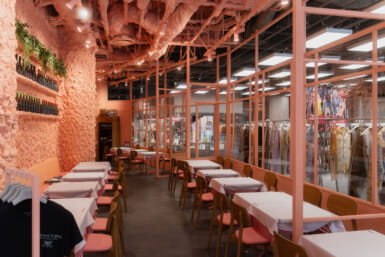A historical warren of Bohemian-filled watering holes
by Danielle Tate-Stratton
Now home to over 180 tiny bars, many of them big enough only for you and ten or so of your closest friends (or friends-to-be from off the street), the Golden Gai district of Shinjuku, tucked beside the bustling Kabuki-cho, has a rich, artistic, post-war history.
Originally built in the allied occupation, the districts buildings are dark and ramshackle, alluding to their original tenants—prostitutes and sex workers—contributors to a ‘water world’ or mizu shobai, more likely to be thought of in conjunction with Asakusa. As the occupation broke up, so too did the sex industry in Golden Gai, though the shadowy feeling in the district was retained as ‘mama-sans’ moved in to sell alcohol as opposed to sex, and the whole district resisted the modernization sweeping through the city at breakneck speed.
The 60s and 70s saw Golden Gai transformed into a warren of bars for artistic types; a retreat for the outcasts and fringe dwellers of Tokyo society. It quickly became an artistic haven and remains so to this day, with individual bars catering individually to writers, artists, photographers, and the like. Tokyo’s intellectuals too, find solace in the tiny bars of Golden Gai—where strangers drunkenly discus philosophy, politics, and their next great idea.
Among the most famous of these bars, perhaps, is Jetee, which has been playing host to a film and photography crowd for roughly 30 years. Francis Ford Coppola has visited the bar, and Juliette Binoche and Chris Marke make fairly regular appearances, as does Wim Wenders, who even shot the bar in his film Tokyo-Ga.
Tokyo’s intellectuals too, find
solace in the tiny bars of Golden
Gai—where strangers drunkenly
discus philosophy, politics, and
their next great idea..
Golden Gai flourished around the time Jetee opened, and then, like so many small districts, faced overwhelming forces in the shape of developers looking to capitalize on the land value boom of Tokyo’s bubble economy. While some bar owners sold out, many didn’t, and because there are so many owners in such a small space, no developer could gain control over the area and re-develop it. As the economy crashed, many buildings, bought but not developed, were left vacant, until a change in the realty laws in 2000 allowed for a new type of contract that meant rents could be lowered. This allowed a new wave of young, entrepreneurial, bohemians to move in and has led to resurgence in the area, with new bars sprouting up to take their place beside oldies such as Julien Sorel, opened roughly fifty years ago.
Golden Gai is located in Shinjuku, near the east exit of the station. It takes up only one block (1-1-8 Kabukicho), and is located off Yasakuni Dori near the Hanaono shrine. The area is so small you can simply walk around until you find a nomiya (counter bar) that looks friendly, welcoming, and catered towards your particular artistic bent. Two favorite, foreigner-friendly bars in the area are Shadow (03-3209-9539) and Jetee (03-3208-9645).









